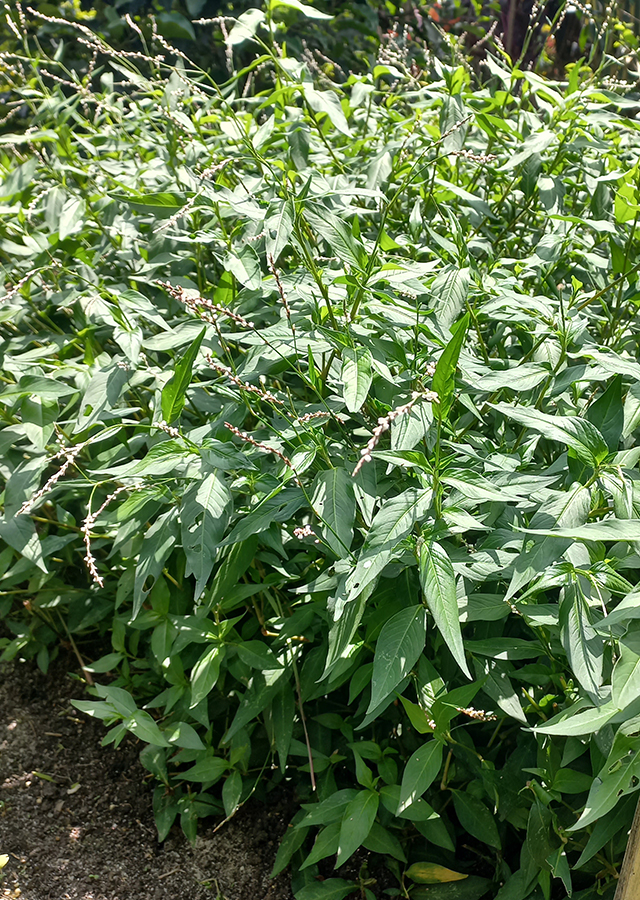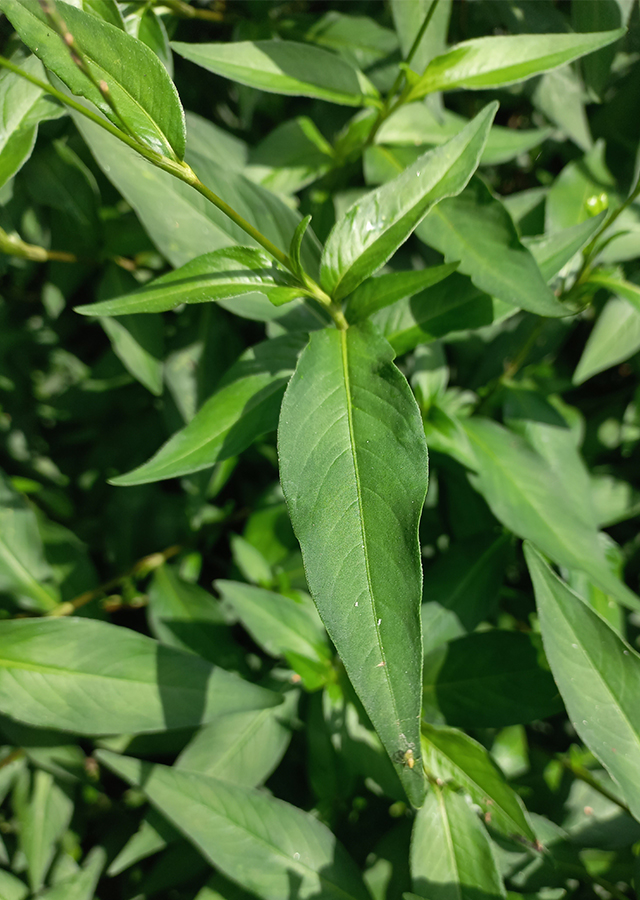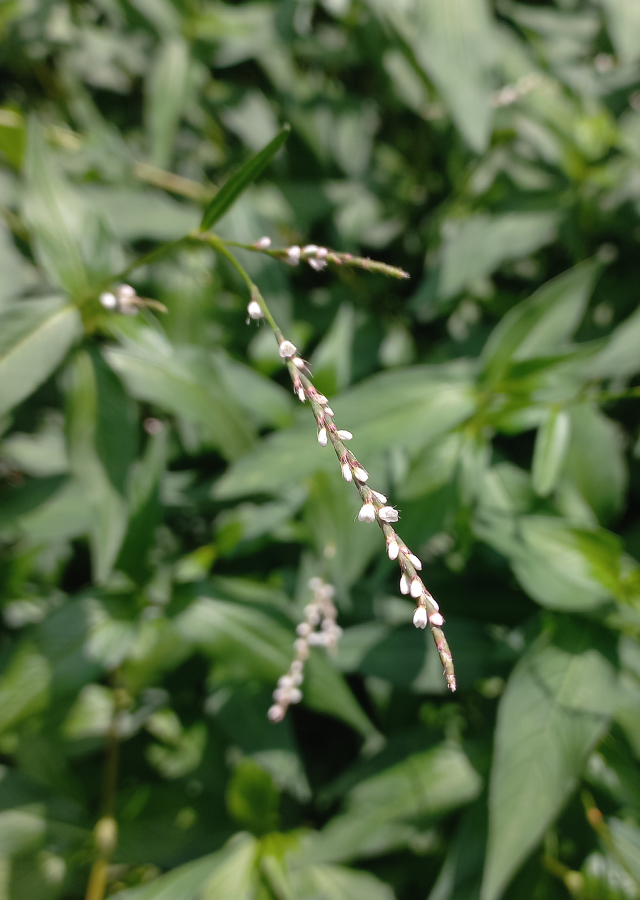Water Pepper
Persicaria hydropiper (L.) Delarbre
Polygonaceae
Location in our garden
Principal



Synonym
Persicaria acris Gray
Peutalis hydropiper (L.) Raf.
Polygonum hydropiper L.
Habitus
Herbaceous. An erect, annual herb that can grow 40-70 cm tall.
Part Used
Leaves
Roots
The Whole Plant
Growing Requirements
Full Sunshine
Low Temperature
Habitat
Wetland
Riverbanks
Overview
Persicaria hydropiper, its native range is temperate Eurasia to West and Central Malesia, North West Africa. The plant is harvested from the wild for local use as a food ad medicine. Leaves and stems are edible, raw or cooked. Seeds made into a peppery condiment as substitute for pepper. Young seeds used as salad garnish. In Japan, young shoots used as spice and garnish with raw fish (sashimi). A yellow-gold dye is obtained from the stalks. It has a long history of herbal use, both in Eastern and Western herbalism. It is not used very often, and is seen more as a domestic remedy being valued especially for its astringent properties which makes it useful in treating bleeding, skin problems, diarrhoea etc. In Chinese tests, the plant was ranked 20th in a survey of 250 potential antifertility drugs.
Vernacular Names
Persicaria picante (Spanish), Persicaire acre (French), Pfeffer-Knöterich (German), Hung la-liao (Chinese), Bitterblad (Swedish), Bishkatal (India), Yanagitabe (Japanese), Phak Phai Nam (Thai), Buding (Philippines), Daun senahun (Malaysia).
Agroecology
Persicaria hydropiper occurs in open waste places, fields and in sunny, wet locations, from sea-level up to 1,500 m altitude. It is a very widespread plant, found growing from the cold temperate zone to the tropics. A water plant, growing in shallow water or wet soils. Dislikes shade. The species grows well in most soils including silts, peats, loams and sands, and whilst tolerating a wide range of pH frequently grows better in more acid situations.
Morphology
- Root - has a taproot that may grow to over 1 m deep.
- Stems - smooth and hairless to very finely hairy, swollen at the nodes, green to red or light brown, and are surrounded above each node by cylindrical membranous ochreas which are 0.5-1 cm long with bristly tips. The stems normally branch towards their tips.
- Leaves - the single leaves have short stalks which taper into slender finely hairy glandular blades 4-10 cm long. Emerging leaves are rolled downwards at the edges. Modified stipules known as ochreae sheath the stem above the junction of stem and petiole. In P. hydropiper these are about 5 mm long with a fringe of hairs about the same length.
- Flowers - inflorescences occur at the tips of all branches and in the upper leaf axils. Each is a slender (often nodding) spike of well-spaced green to pink flowers, 2-4 mm long, the outer parts of which are covered with dark glands.
- Fruit - an achene, 2-3-sided, 2-3 mm long, brown-black.
Cultivation
- Generative propagation is by seed - sow in a pot standing in water or in situ. Germination is usually free and easy. When they are large enough to handle, prick the seedlings out into individual pots and plant them out when large enough.
- Vegetative propagation is by broken stems that may root at the nodes and grow into new plants.
Chemical Constituents
Polygonic acid, essential oils, malic acid, phytosterols, oxymethyl-anthraquinone, alkaloids, flavonoids (such as catechin, (−)-epicatechin, hyperin, isoquercitrin, isorhamnetin, kaempferol, quercetin, quercitrin, rhamnazin and rutin), saponins, tannins, terpenoids, sesquiterpenes (such as 3-β-angeloyloxy-7-epifutronolide, 7-ketoisodrimenin, changweikangic acid A, dendocarbin L, (+)-fuegin, futronolide, polygonumate), steroids, phenolic acids (such as caffeic acid, chlorogenic acid and ρ-coumaric acid).
Traditional Medicinal Uses
- Studies have suggested antioxidant, antibacterial, antifungal, anthelmintic, cytotoxic, anti-inflammatory, antinociceptive, antifertility, anti-obesity and neuroprotective properties.
- Considered anti-inflammatory, astringent, carminative, contraceptive, diaphoretic, diuretic, emmenagogue, stimulant, stomachic, styptic.
- The seed is carminative, diuretic and stimulant.
- The bruised leaves are used as a poultice and as a remedy for toothache.
- Helps strengthen fragile capillaries and thus helps prevent bleeding.
- The whole plant, either on its own or mixed with other herbs, is decocted and used in the treatment of a wide range of ailments including diarrhoea, dyspepsia, itching skin, excessive menstrual bleeding and haemorrhoids.
- A poultice of the plant is used in treating swollen and inflamed areas.
- The root is bitter, stimulant and tonic.
Part Used
Reference Sources
- CAB International. (2022). Invasive Spesies Compendium: Polygonum hydropiper (marsh pepper). https://www.cabi.org/isc/datasheet/42688#toPictures. 15-08-2022.
- Fern, Ken. (2021). Useful Tropical Plants: Persicaria hydropiper. http://tropical.theferns.info/viewtropical.php?id=Persicaria+hydropiper&redir=Polygonum+hydropiper. 15-08-2022.
- Huq A. K. M. M., Jamal J. A., Stanslas J. (2014). Ethnobotanical, Phytochemical, Pharmacological, and Toxicological Aspects of Persicaria hydropiper (L.) Delarbre. Hindawi Publishing Corporation. Evidence-Based Complementary and Alternative Medicine.
Volume 2014. http://dx.doi.org/10.1155/2014/782830. - Jansen, P.C.M. (2016). Persicaria hydropiper (PROSEA). https://uses.plantnet-project.org/en/Persicaria_hydropiper_(PROSEA). 15-08-2022.
- Kew Royal Botanic Gardens. (No date). Plants of the World Online: Persicaria hydropiper (L.) Delarbre. https://powo.science.kew.org/taxon/urn:lsid:ipni.org:names:77069479-1. 15-08-2022.
- Stuartxchange. (2020). Philippine Medicinal Plants: Persicaria hydropiper (L.) Delarbre. http://www.stuartxchange.org/Buding. 15-08-2022.


